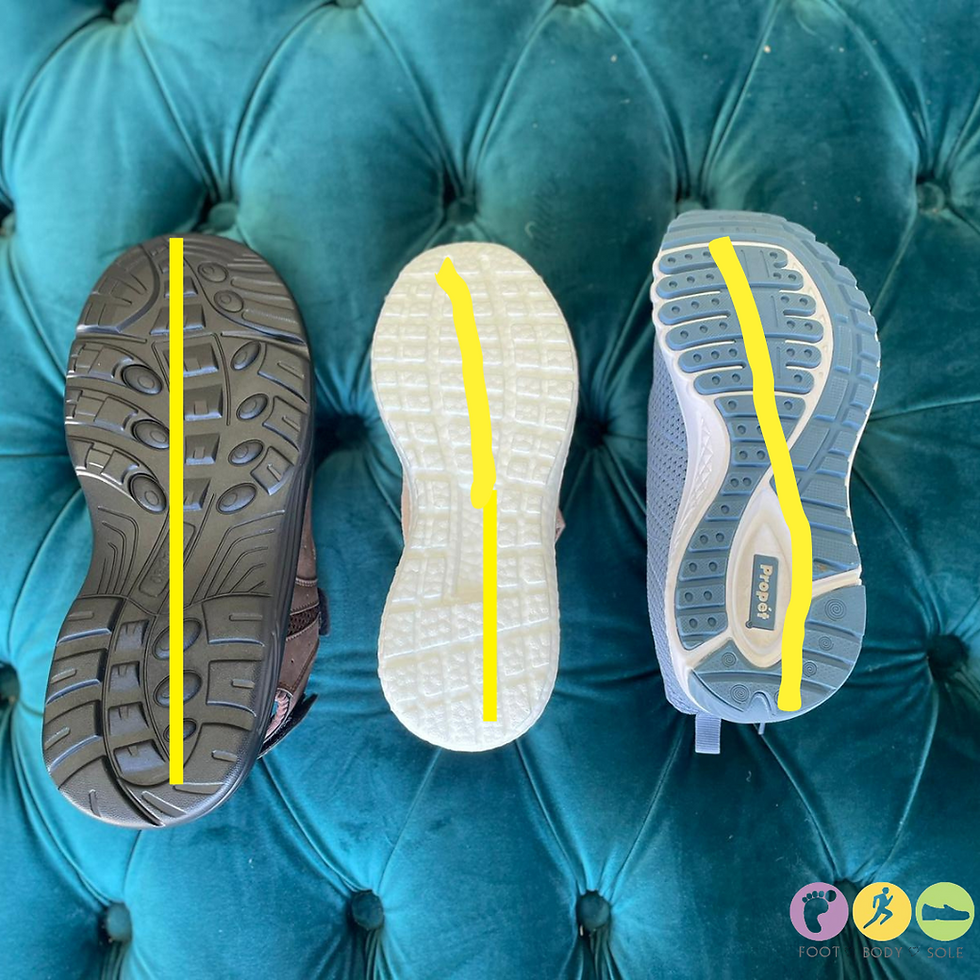Straight vs Curved lasts in Footwear
- Foot Body Sole
- Aug 22, 2022
- 4 min read
WHAT YOU SHOULD BE LOOKING FOR ACCORDING TO YOUR FOOT TYPE

Footwear is a big question mark for a lot of people.
Where to buy... when to buy... what to buy!
Particularly, for those who like runner- type shoes (which is, to be honest, all the rage at the moment!), the choices are extremely diverse and confusing.
Generally, Podiatrists will consider a few features of a shoe when deciding if it is the correct shoe for your foot.
These considerations include:
WIDTH Shoes should be wide enough so that toes are not squashed together as this can lead to corns, metatarsalgia- type pain (in the forefoot) and changes to the position of the toes.
LENGTH Shoes should be long enough so the longest toe does not touch the end of the shoe, and has around 1 finger's width (of the person wearing the shoe) between the end of their toe and the end of the shoe. This is to allow for slight movement of the feet within the shoe when exercising. Toes touching the end of the shoe may result in retracting digits, callus and corns and nail deformities.
FIXATION Laces, buckles, velcro fixations are always preferred in quality shoes because they allow for differences in width and arch height of feet, and potentially innersoles if required. Additionally, lacing patterns may be changed to accommodate bony deformities or reduce slippage in the heels.
STRUCTURE Shoes should be firm in the midsole (middle of the shoe) so that the shoe cannot be bent out of shape or distorted. Having a structured midsole allows for long- term support for the feet.
HEEL COUNTER The back and sides of the heel region of a shoe should be firm and not able to be distorted by firm pressure. Allowing the heels to be supported by a more stiff heel counter in a shoe supports the rear-foot and reduces unwanted movement during walking.
HEEL HEIGHT Heel height should be a maximum of around 2.5cm of difference between the heel and the forefoot sole. A slightly higher heel than forefoot supports the achilles tendon and plantar fascia when exercising, however too high and excess strain is placed on the forefoot.
AGE Shoes should not exceed 500km before being changed. Yes this sounds like a very quick turnaround, however the support in the sole and heel counter wears down quite quickly and lacks support usually before being noticed by the wearer.
LAST SHAPE Last shape is what we came to chat about today! SEE BELOW

WHAT IS A LAST?
A last is a foot- shaped mould used to create shoes. Lasts have been used for centuries to create a similar shape and size of shoe. They can be made of wood, plastic or metal.
The last gives the shape of the shoe
Last Shape: lasts are shaped in a variety of ways depending on the style of shoe.
For running shoes, lasts are generally placed into 3 categories.
Straight Lasts. You can tell a straight last by being able to draw a straight line from the middle of the heel, through to where the 2nd toe would be placed in the shoe (middle of the forefoot). This shoe is best for flat (pronated) type feet or someone with a low arch. Usually, straight last shoe types have additional reinforcement in the sole in the midsection which allows for additional support.
Semi Curved Lasts. A semi- curved last is where the front section of the shoe is slightly curved compared with the heel section. This shoe is more appropriate for people with "normal" feet who do not have either a very flat foot or very high arch. Most running shoes are a semi- curved design.
Curved lasts. Shoes with a curved last are best suited to people with a high- arched foot (Supinated) when weight-bearing. The Curved last allows for the differences of pressure with a higher arched foot when compared with a flatter- type foot. Reinforced support in these curved last shoes is centred around the heel and forefoot regions, with less in the midsection of the shoe as typically the Supinated foot can support its' self well.
What should I choose for my foot?
TIP: Stand up straight and look down at your feet. If you can see a gap where your arch does not meet the floor, consider a semi- curved or curved last. If you are standing and cannot see any space between the floor and your arch, then consider a straight last shoe.
This is a guide only. A Podiatrist can direct you as to the specifics of your foot position and
which type of shoe suits your feet the best. Having your feet assessed can also provide an opportunity for foot health education, strengthening and stretching discussions alongside individual shoe brand recommendations based on your individual feet.

TIPS FOR CHECKING IF SHOES ARE TOO OLD 1. can you press the heel in?
2. can you bend the sole in half/wring it out like a towel?
3. Look underneath, is the outer layer of the sole worn off or down? -if any are yes, consider new shoes!
If you have any questions give us a call at 03 8648 7678 or come into 108 Bridport st Albert Park to say hi, or visit us at footbodysole.com.au and book an appointment to see one of your lovely Podiatrists for your foot and shoe needs.








Comments